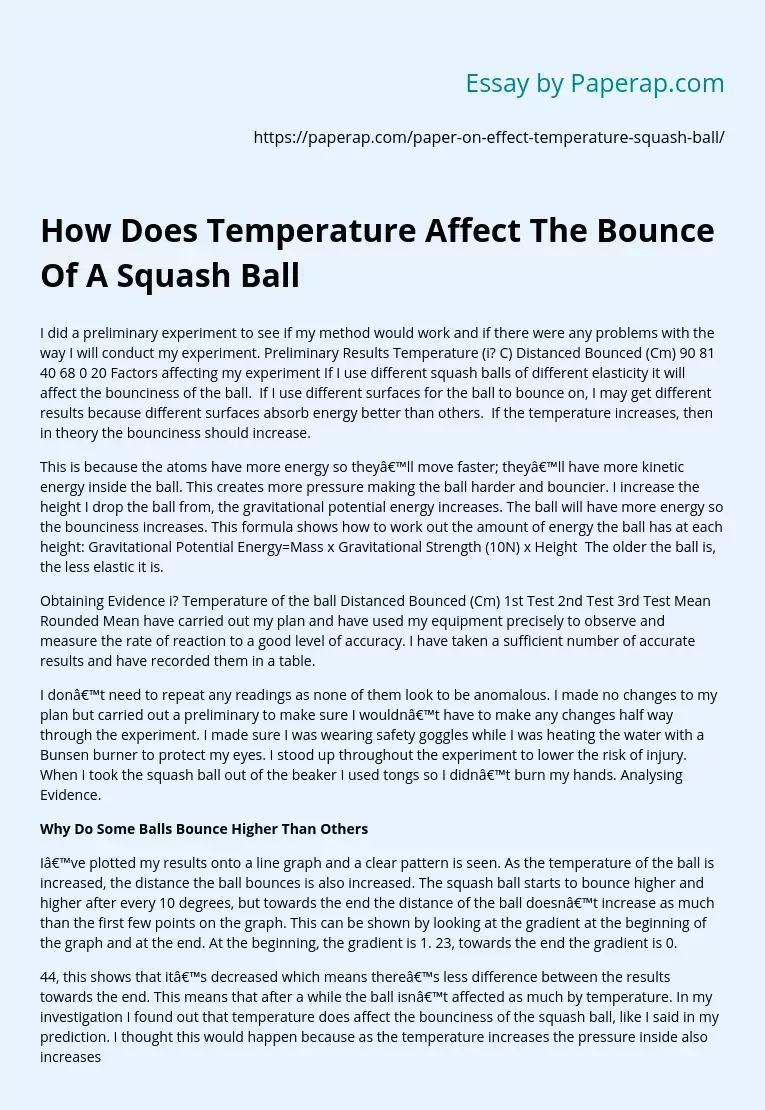How Does Temperature Affect The Bounce Of A Squash Ball
I did a preliminary experiment to see if my method would work and if there were any problems with the way I will conduct my experiment. Preliminary Results Temperature (i? C) Distanced Bounced (Cm) 90 81 40 68 0 20 Factors affecting my experiment If I use different squash balls of different elasticity it will affect the bounciness of the ball. If I use different surfaces for the ball to bounce on, I may get different results because different surfaces absorb energy better than others. If the temperature increases, then in theory the bounciness should increase.
This is because the atoms have more energy so they’ll move faster; they’ll have more kinetic energy inside the ball. This creates more pressure making the ball harder and bouncier. I increase the height I drop the ball from, the gravitational potential energy increases. The ball will have more energy so the bounciness increases. This formula shows how to work out the amount of energy the ball has at each height: Gravitational Potential Energy=Mass x Gravitational Strength (10N) x Height The older the ball is, the less elastic it is.
Obtaining Evidence i? Temperature of the ball Distanced Bounced (Cm) 1st Test 2nd Test 3rd Test Mean Rounded Mean have carried out my plan and have used my equipment precisely to observe and measure the rate of reaction to a good level of accuracy. I have taken a sufficient number of accurate results and have recorded them in a table.
I don’t need to repeat any readings as none of them look to be anomalous.
I made no changes to my plan but carried out a preliminary to make sure I wouldn’t have to make any changes half way through the experiment. I made sure I was wearing safety goggles while I was heating the water with a Bunsen burner to protect my eyes. I stood up throughout the experiment to lower the risk of injury. When I took the squash ball out of the beaker I used tongs so I didn’t burn my hands. Analysing Evidence.
Why Do Some Balls Bounce Higher Than Others
I’ve plotted my results onto a line graph and a clear pattern is seen. As the temperature of the ball is increased, the distance the ball bounces is also increased. The squash ball starts to bounce higher and higher after every 10 degrees, but towards the end the distance of the ball doesn’t increase as much than the first few points on the graph. This can be shown by looking at the gradient at the beginning of the graph and at the end. At the beginning, the gradient is 1. 23, towards the end the gradient is 0.
44, this shows that it’s decreased which means there’s less difference between the results towards the end. This means that after a while the ball isn’t affected as much by temperature. In my investigation I found out that temperature does affect the bounciness of the squash ball, like I said in my prediction. I thought this would happen because as the temperature increases the pressure inside also increases making the ball harder and bouncier. The pressure increases because the atoms are moving around with more force and faster because they have more energy.
My results back this up. I don’t have any extreme anomalies but my second point on the graph is a bit anomalous. This could be or a number of reasons due to human error. For example I might not have seen the distance the ball bounced correctly, or I might have dropped the ball a little bit lower than the other times. Evaluation The evidence I obtained was good for the simplicity of my investigation. I think the way in which my investigation was carried out was effective but could have been more accurate.
For example, I carried out all of it. If I used machines or computers it would have been a lot more accurate. If I had the equipment to this I would have a machine drop the squash ball from an exact point and use either or video camera or light motion sensor to get the exact measurement of the bounce. This would be a lot more accurate than my own eyesight. But saying that, my results were very accurate without machines and I can see this by how I’ve plotted them on the graph.
They were easily accurate enough to make a firm conclusion on that increasing the temperature increases the bounciness of the ball. There weren’t any results that didn’t fit into the main pattern. I think this is because I took great care while carrying out the experiment. There are many other experiments I could do to extend the work I’ve done. For example I could look at all the other factors that affect the bounciness which I mentioned in my plan. I think an interesting one would be to change the material the ball lands on, to see which material absorbs the most energy.
How Does Temperature Affect The Bounce Of A Squash Ball. (2019, Dec 05). Retrieved from https://paperap.com/paper-on-effect-temperature-squash-ball/

